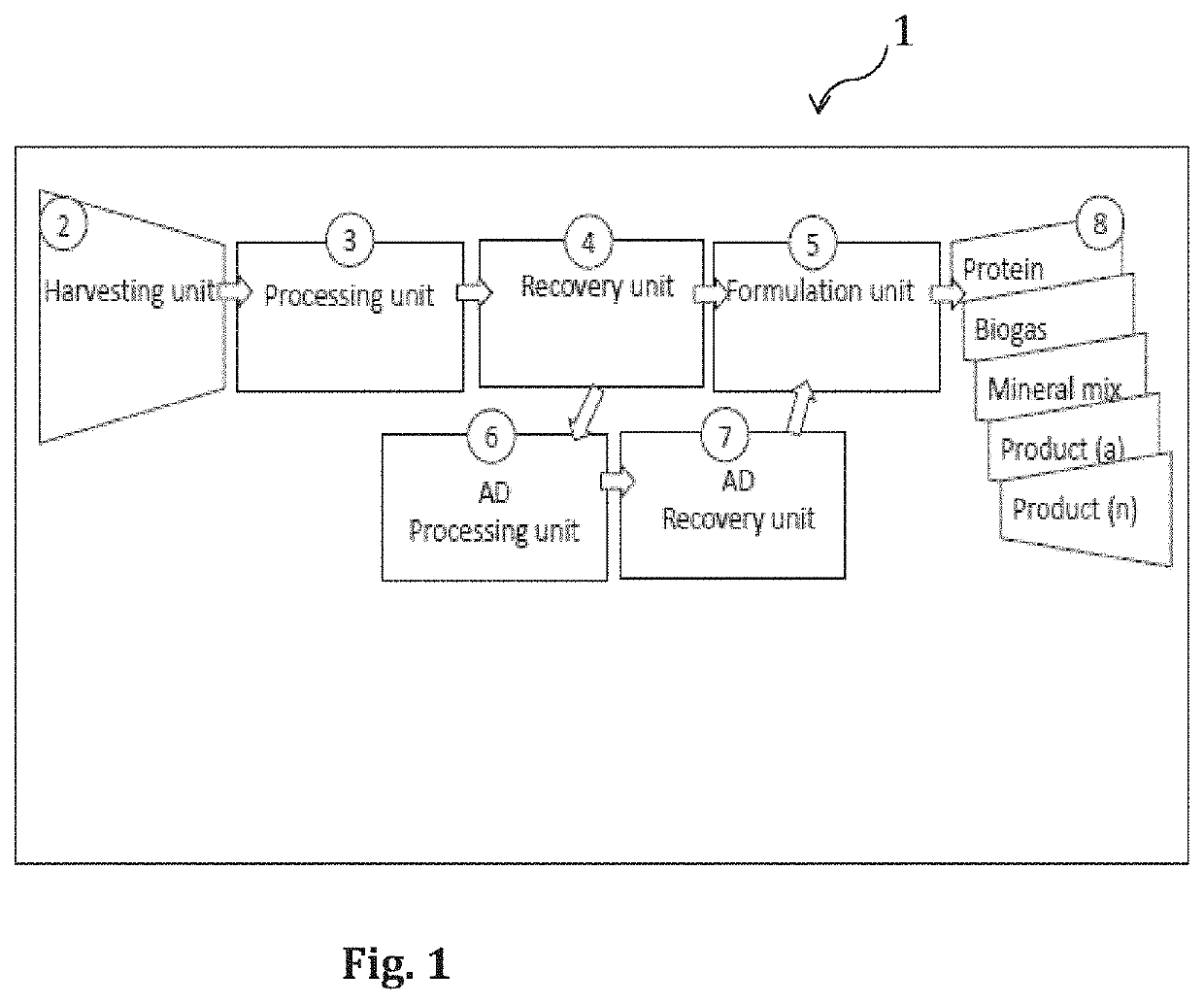Method for cascaded processing of fresh algae
a cascaded processing and algae technology, applied in bakery products, applications, peptide sources, etc., can solve the problems of avoiding the transportation of a lot of water, heavy and costly, and algae cannot be used for food, pharma or cosmetic applications anymor
- Summary
- Abstract
- Description
- Claims
- Application Information
AI Technical Summary
Benefits of technology
Problems solved by technology
Method used
Image
Examples
example 1 processing
of Green Algae Using the Method According to the Invention
[0053]Fresh green algae (Ulva Lactuca, 5 kg) were harvested and washed using an excess of fresh sea water of a temperature of maximally 20 degrees C. Attached water was removed by low speed centrifugation. Then 5 liters of demineralised, chilled water was added and the mixture was chopped in a blender until pieces of approximately 1 sq mm were obtained. The sliced biomass was divided into two parts. To one part, the control, 25 ml demineralised water was added. The other part was incubated with 25 ml of a ten times diluted enzyme preparation A for release of the cell contents within one hour after harvesting.
[0054]Both parts were stirred for 24 hours at room temperature (actually <20 C) and then centrifuged at 4 degrees C., 4500 rpm for 10 minutes and the supernatant was collected. The pellet was resuspended in demineralised water, centrifuged again and the supernatant collected and added to the first supernatant. Collected s...
example 2 processing
of Red Algae Using the Method According to the Invention
[0055]Fresh red algae (Gracillaria, 5 kg) were harvested and washed using an excess of fresh sea water of a temperature of maximally 20 degrees C. Attached water was removed by low speed centrifugation and cut into pieces of approximately 1 sq. mm and further treated as described in Example 1, including enzyme treatment within two hours after harvesting. Collected supernatants were frozen until further analysis. Further analysis showed that the supernatant from Gracillaria contained protein. Also another type of red algae, fresh Chondrus, were harvested and processed using the protocol as described in Example 1, including enzyme treatment within two hours after harvesting. Collected supernatants were frozen until further analysis. Further analysis showed that the supernatant from Chondrus contained protein. This shows that protein can be isolated from red algae using the gentle process according to the invention.
example 3 processing
of Brown Algae Using the Method According to the Invention
[0056]Fresh brown algae (Fucus) were harvested and washed using an excess of fresh sea water of a temperature of maximally 20 degrees C. Attached water was removed by low speed centrifugation and algae cut into pieces of approximately 1 sq. mm and further treated as described in Example 1, including enzyme treatment within two hours after harvesting. Collected supernatants were frozen until further analysis. Further analysis showed that the supernatant contained protein. This example shows that the process according to the invention also may be used for protein isolation from brown algae.
Example 4 Large Scale Processing of Fresh Ulva for Isolation of Protein and Production of Biogas in a Cascaded Process
[0057]Green algae (Ulva lactuca, 76 kg) were harvested and washed using an excess of fresh seawater of a temperature of maximum 20 degrees C. Attached water was removed by low speed centrifugation. Portions of 1 kg seaweed was...
PUM
| Property | Measurement | Unit |
|---|---|---|
| temperature | aaaaa | aaaaa |
| temperature | aaaaa | aaaaa |
| pH | aaaaa | aaaaa |
Abstract
Description
Claims
Application Information
 Login to View More
Login to View More - R&D
- Intellectual Property
- Life Sciences
- Materials
- Tech Scout
- Unparalleled Data Quality
- Higher Quality Content
- 60% Fewer Hallucinations
Browse by: Latest US Patents, China's latest patents, Technical Efficacy Thesaurus, Application Domain, Technology Topic, Popular Technical Reports.
© 2025 PatSnap. All rights reserved.Legal|Privacy policy|Modern Slavery Act Transparency Statement|Sitemap|About US| Contact US: help@patsnap.com

